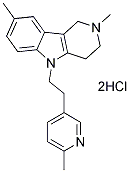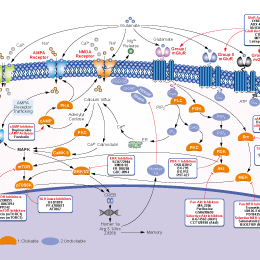
- Bioactive Compounds
- By Signaling Pathways
- PI3K/Akt/mTOR
- Epigenetics
- Methylation
- Immunology & Inflammation
- Protein Tyrosine Kinase
- Angiogenesis
- Apoptosis
- Autophagy
- ER stress & UPR
- JAK/STAT
- MAPK
- Cytoskeletal Signaling
- Cell Cycle
- TGF-beta/Smad
- DNA Damage/DNA Repair
- Compound Libraries
- Popular Compound Libraries
- Customize Library
- Clinical and FDA-approved Related
- Bioactive Compound Libraries
- Inhibitor Related
- Natural Product Related
- Metabolism Related
- Cell Death Related
- By Signaling Pathway
- By Disease
- Anti-infection and Antiviral Related
- Neuronal and Immunology Related
- Fragment and Covalent Related
- FDA-approved Drug Library
- FDA-approved & Passed Phase I Drug Library
- Preclinical/Clinical Compound Library
- Bioactive Compound Library-I
- Bioactive Compound Library-Ⅱ
- Kinase Inhibitor Library
- Express-Pick Library
- Natural Product Library
- Human Endogenous Metabolite Compound Library
- Alkaloid Compound LibraryNew
- Angiogenesis Related compound Library
- Anti-Aging Compound Library
- Anti-alzheimer Disease Compound Library
- Antibiotics compound Library
- Anti-cancer Compound Library
- Anti-cancer Compound Library-Ⅱ
- Anti-cancer Metabolism Compound Library
- Anti-Cardiovascular Disease Compound Library
- Anti-diabetic Compound Library
- Anti-infection Compound Library
- Antioxidant Compound Library
- Anti-parasitic Compound Library
- Antiviral Compound Library
- Apoptosis Compound Library
- Autophagy Compound Library
- Calcium Channel Blocker LibraryNew
- Cambridge Cancer Compound Library
- Carbohydrate Metabolism Compound LibraryNew
- Cell Cycle compound library
- CNS-Penetrant Compound Library
- Covalent Inhibitor Library
- Cytokine Inhibitor LibraryNew
- Cytoskeletal Signaling Pathway Compound Library
- DNA Damage/DNA Repair compound Library
- Drug-like Compound Library
- Endoplasmic Reticulum Stress Compound Library
- Epigenetics Compound Library
- Exosome Secretion Related Compound LibraryNew
- FDA-approved Anticancer Drug LibraryNew
- Ferroptosis Compound Library
- Flavonoid Compound Library
- Fragment Library
- Glutamine Metabolism Compound Library
- Glycolysis Compound Library
- GPCR Compound Library
- Gut Microbial Metabolite Library
- HIF-1 Signaling Pathway Compound Library
- Highly Selective Inhibitor Library
- Histone modification compound library
- HTS Library for Drug Discovery
- Human Hormone Related Compound LibraryNew
- Human Transcription Factor Compound LibraryNew
- Immunology/Inflammation Compound Library
- Inhibitor Library
- Ion Channel Ligand Library
- JAK/STAT compound library
- Lipid Metabolism Compound LibraryNew
- Macrocyclic Compound Library
- MAPK Inhibitor Library
- Medicine Food Homology Compound Library
- Metabolism Compound Library
- Methylation Compound Library
- Mouse Metabolite Compound LibraryNew
- Natural Organic Compound Library
- Neuronal Signaling Compound Library
- NF-κB Signaling Compound Library
- Nucleoside Analogue Library
- Obesity Compound Library
- Oxidative Stress Compound LibraryNew
- Plant Extract Library
- Phenotypic Screening Library
- PI3K/Akt Inhibitor Library
- Protease Inhibitor Library
- Protein-protein Interaction Inhibitor Library
- Pyroptosis Compound Library
- Small Molecule Immuno-Oncology Compound Library
- Mitochondria-Targeted Compound LibraryNew
- Stem Cell Differentiation Compound LibraryNew
- Stem Cell Signaling Compound Library
- Natural Phenol Compound LibraryNew
- Natural Terpenoid Compound LibraryNew
- TGF-beta/Smad compound library
- Traditional Chinese Medicine Library
- Tyrosine Kinase Inhibitor Library
- Ubiquitination Compound Library
-
Cherry Picking
You can personalize your library with chemicals from within Selleck's inventory. Build the right library for your research endeavors by choosing from compounds in all of our available libraries.
Please contact us at [email protected] to customize your library.
You could select:
- Antibodies
- Bioreagents
- qPCR
- 2x SYBR Green qPCR Master Mix
- 2x SYBR Green qPCR Master Mix(Low ROX)
- 2x SYBR Green qPCR Master Mix(High ROX)
- Protein Assay
- Protein A/G Magnetic Beads for IP
- Anti-Flag magnetic beads
- Anti-Flag Affinity Gel
- Anti-Myc magnetic beads
- Anti-HA magnetic beads
- Magnetic Separator
- Poly DYKDDDDK Tag Peptide lyophilized powder
- Protease Inhibitor Cocktail
- Protease Inhibitor Cocktail (EDTA-Free, 100X in DMSO)
- Phosphatase Inhibitor Cocktail (2 Tubes, 100X)
- Cell Biology
- Cell Counting Kit-8 (CCK-8)
- Animal Experiment
- Mouse Direct PCR Kit (For Genotyping)
- New Products
- Contact Us
Latrepirdine 2HCl
Latrepirdine is an orally active,and neuroactive antagonist of multiple drug targets, including histamine receptors, GluR, and 5-HT receptors, used as an antihistamine drug.

Latrepirdine 2HCl Chemical Structure
CAS No. 97657-92-6
Purity & Quality Control
Batch:
Purity:
99.96%
99.96
Latrepirdine 2HCl Related Products
| Related Targets | NMDA receptor AMPA receptor mGluR2 mGluR3 mGluR4 mGluR5 | Click to Expand |
|---|---|---|
| Related Products | pomaglumetad (LY404039) O-Phospho-L-serine (S)-Glutamic acid CTEP (RO4956371) Capric acid MPEP VU 0364439 ADX-47273 Xanthurenic Acid SIB 1757 L-Glutamic acid monosodium salt | Click to Expand |
| Related Compound Libraries | FDA-approved Drug Library Natural Product Library Neuronal Signaling Compound Library CNS-Penetrant Compound Library Anti-alzheimer Disease Compound Library | Click to Expand |
Signaling Pathway
Biological Activity
| Description | Latrepirdine is an orally active,and neuroactive antagonist of multiple drug targets, including histamine receptors, GluR, and 5-HT receptors, used as an antihistamine drug. | |||
|---|---|---|---|---|
| Targets |
|
| In vitro | ||||
| In vitro | Latrepirdine increases succinate dehydrogenase activity (MTT-assay), mitochondrial membrane potential (DeltaPsim), and cellular ATP levels in primary mouse cortical neurons and human neuroblastoma cells (SH-SY5Y). Latrepirdine enhances mitochondrial function both in the absence and presence of stress and Dimebon-treated cells are partially protected to maintain cell viability. [1] Latrepirdine leads to enhanced mTOR- and Atg5-dependent autophagy in cultured mammalian cells. [2] latrepirdine stimulates MTOR- and ATG5-dependent autophagy, leading to the reduction of intracellular levels of APP metabolites, including Aβ in cultured cells. [3] Latrepirdine stimulates the degradation of α-syn in differentiated SH-SY5Y neurons, and in mouse brain following chronic administration, in parallel with elevation of the levels of markers of autophagic activity. [4] Latrepirdine increases intracellular ATP levels and glucose transporter 3 translocation to the plasma membrane in primary neuron. [5] | |||
|---|---|---|---|---|
| In Vivo | ||
| In vivo | Latrepirdine treatment of TgCRND8 transgenic mice is associated with improved learning behavior and with a reduction in accumulation of Aβ42 and α-synuclein. [2] Latrepirdine administration results in increased levels of the biomarkers thought to correlate with autophagy activation in the brains of TgCRND8 (APP K670M, N671L, V717F) or wild-type mice, and that treatment is associated with abrogation of behavioral deficit, reduction in Aβ neuropathology, and prevention of autophagic failure among TgCRND8 mice. [3] | |
|---|---|---|
Chemical Information & Solubility
| Molecular Weight | 392.37 | Formula | C21H25N3.2HCl |
| CAS No. | 97657-92-6 | SDF | -- |
| Smiles | CC1=CC2=C(C=C1)N(C3=C2CN(CC3)C)CCC4=CN=C(C=C4)C.Cl.Cl | ||
| Storage (From the date of receipt) | |||
|
In vitro |
DMSO : 78 mg/mL ( (198.79 mM) Moisture-absorbing DMSO reduces solubility. Please use fresh DMSO.) Ethanol : 26 mg/mL Water : Insoluble |
Molecular Weight Calculator |
|
In vivo Add solvents to the product individually and in order. |
In vivo Formulation Calculator |
||||
Preparing Stock Solutions
Molarity Calculator
In vivo Formulation Calculator (Clear solution)
Step 1: Enter information below (Recommended: An additional animal making an allowance for loss during the experiment)
mg/kg
g
μL
Step 2: Enter the in vivo formulation (This is only the calculator, not formulation. Please contact us first if there is no in vivo formulation at the solubility Section.)
% DMSO
%
% Tween 80
% ddH2O
%DMSO
%
Calculation results:
Working concentration: mg/ml;
Method for preparing DMSO master liquid: mg drug pre-dissolved in μL DMSO ( Master liquid concentration mg/mL, Please contact us first if the concentration exceeds the DMSO solubility of the batch of drug. )
Method for preparing in vivo formulation: Take μL DMSO master liquid, next addμL PEG300, mix and clarify, next addμL Tween 80, mix and clarify, next add μL ddH2O, mix and clarify.
Method for preparing in vivo formulation: Take μL DMSO master liquid, next add μL Corn oil, mix and clarify.
Note: 1. Please make sure the liquid is clear before adding the next solvent.
2. Be sure to add the solvent(s) in order. You must ensure that the solution obtained, in the previous addition, is a clear solution before proceeding to add the next solvent. Physical methods such
as vortex, ultrasound or hot water bath can be used to aid dissolving.
Tech Support
Answers to questions you may have can be found in the inhibitor handling instructions. Topics include how to prepare stock solutions, how to store inhibitors, and issues that need special attention for cell-based assays and animal experiments.
Tel: +1-832-582-8158 Ext:3
If you have any other enquiries, please leave a message.
* Indicates a Required Field
Tags: buy Latrepirdine 2HCl | Latrepirdine 2HCl ic50 | Latrepirdine 2HCl price | Latrepirdine 2HCl cost | Latrepirdine 2HCl solubility dmso | Latrepirdine 2HCl purchase | Latrepirdine 2HCl manufacturer | Latrepirdine 2HCl research buy | Latrepirdine 2HCl order | Latrepirdine 2HCl mouse | Latrepirdine 2HCl chemical structure | Latrepirdine 2HCl mw | Latrepirdine 2HCl molecular weight | Latrepirdine 2HCl datasheet | Latrepirdine 2HCl supplier | Latrepirdine 2HCl in vitro | Latrepirdine 2HCl cell line | Latrepirdine 2HCl concentration | Latrepirdine 2HCl nmr







































